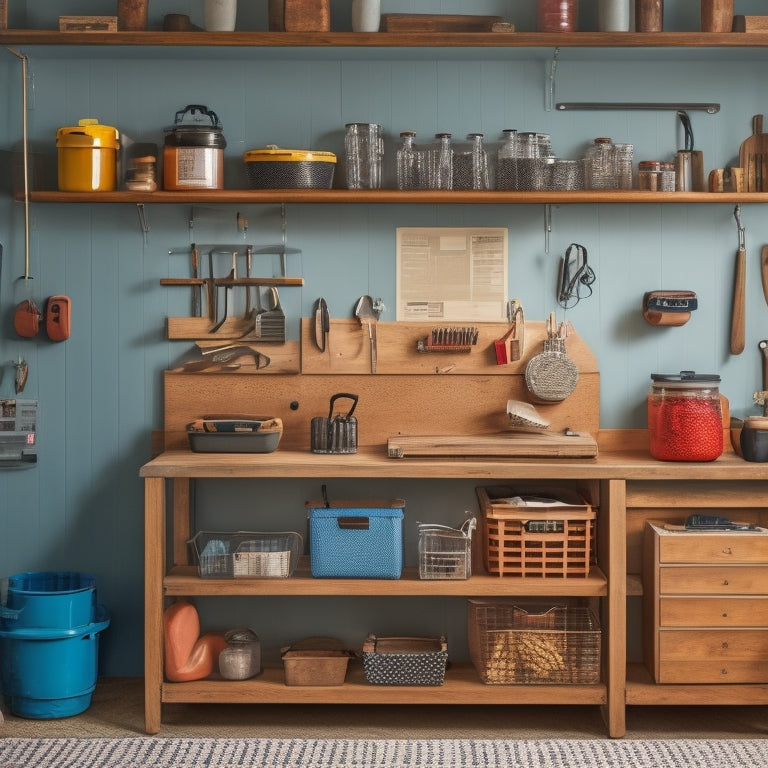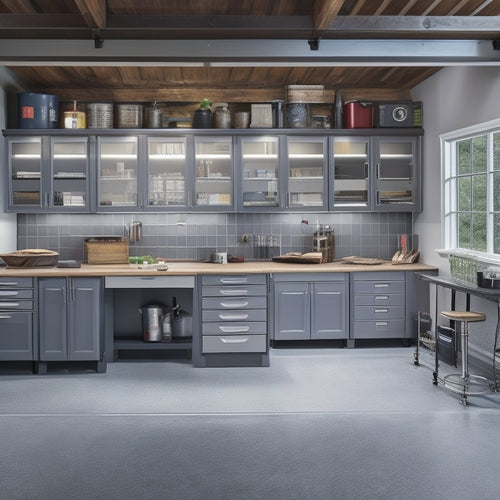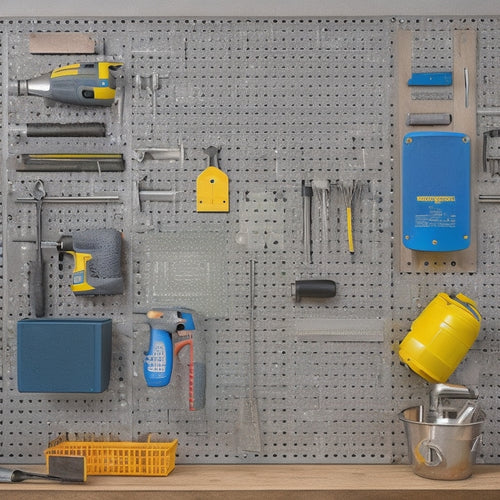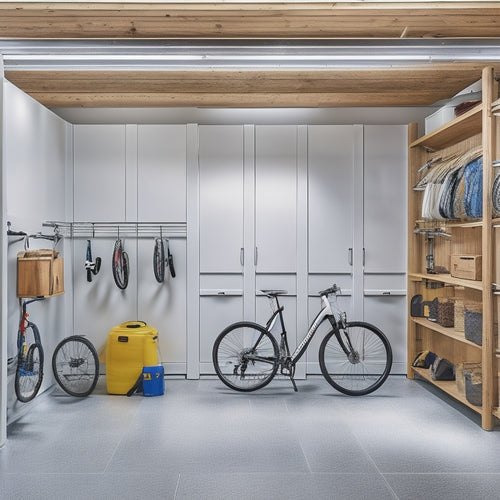
Boosting Tool Storage in Compact Workshops Easily
Share
You're likely no stranger to the frustration of maneuvering a cramped workshop. To boost tool storage in your compact workshop, start by optimizing your layout to identify dead zones for repurposing. Then, utilize vertical space with shelves, hooks, and bins to free up floor space. Choose multifunctional tool holders and space-saving tool chests to maximize storage. Install adjustable shelving systems to customize your storage setup. Implement tool organization systems, consider modular workshop furniture, and maximize corner storage space. Finally, label and categorize your tools clearly. By following these steps, you'll be well on your way to a more efficient workshop - and that's just the beginning.
Key Takeaways
• Implement the golden triangle concept to optimize tool placement and reduce walking distances in compact workshops.
• Utilize vertical storage solutions like pegboards, slatwalls, and shelves to maximize storage capacity and free up floor space.
• Choose multifunctional tool holders and chests with space-saving designs to categorize and store tools efficiently.
• Optimize corner storage with shelves, hanging baskets, and adhesive hooks to make the most of dead zones.
• Label and categorize tools clearly to reduce search time and increase productivity in compact workshops.
Optimize Workshop Layout for Storage
To maximize storage in your compact workshop, start by evaluating the existing layout and identifying areas where workflow can be improved to create space for storage. Take note of the 'dead zones' where tools and materials tend to pile up, and think about how you can repurpose these areas for more efficient tool storage.
Consider the 'golden triangle' concept, where your most frequently used tools are positioned within easy reach to reduce walking distances and increase productivity.
Next, assess your workflow and identify opportunities to streamline tasks and reduce clutter. For instance, can you relocate your workbench to create more floor space or install a pegboard for hanging tools?
By optimizing your compact workshop layout, you'll be able to allocate more space for efficient tool storage. This will help you stay organized, reduce stress, and get more work done in less time.
With a well-planned layout, you'll be able to store more tools in a smaller space, making your compact workshop feel more spacious and functional.
Utilize Vertical Space Effectively
Your compact workshop's walls and ceiling are prime real estate for maximizing storage. Make the most of them by installing shelves, hooks, and bins that keep tools and supplies within easy reach.
By utilizing vertical space effectively, you'll free up floor space and reduce clutter. Start by evaluating your workshop's layout and identifying areas where vertical storage solutions can be implemented. Consider installing pegboards or slatwalls with hooks and bins to store frequently used tools and accessories.
For less frequently used items, install shelves or cabinets that can be easily accessed with a ladder or step stool. Don't forget to make the most of your ceiling space by installing overhead storage racks for items like bikes, kayaks, or other bulky equipment.
Choose Multifunctional Tool Holders
When selecting multifunctional tool holders, you'll want to evaluate holders that can store a variety of tools, such as pliers, screwdrivers, and wrenches, in a single unit.
Look for space-saving designs that can be mounted on walls or ceilings, or opt for adjustable holders that can be reconfigured as your tool collection evolves.
Tool Variety Storage
Five essential tool categories can be efficiently stored using multifunctional tool holders, freeing up valuable space in your compact workshop. By categorizing your tools into groups such as hand tools, power tools, fasteners, measuring tools, and accessories, you can optimize your storage space.
Consider using tool rack ideas like pegboards with hooks and bins to store frequently used tools. For smaller items, storage bin solutions with dividers can keep them organized and easily accessible.
In your cabinet organization, designate specific shelves or drawers for each tool category. Utilize wall-mounted hooks for hanging tools like wrenches, hammers, and saws, keeping them off the floor and out of the way.
Space-Saving Holder Designs
To maximize storage capacity in your compact workshop, opt for tool holders with multiple tiers, adjustable compartments, or rotating designs that can be mounted on walls or placed on countertops. This will help you make the most of your available space.
Consider tool wall mounts that can hold a variety of tools, from hammers to screwdrivers, keeping them organized and within easy reach. Compact tool carts with drawers or shelves can also provide ample storage for smaller tools and accessories.
Don't forget to utilize overhead storage by installing magnetic tool racks or hooks to hang items like bikes, bins, or even tool belts. This will keep your floor clear and create a more efficient workspace.
Adjustable Holder Options
You can customize your tool storage setup with adjustable holder options that accommodate tools of various shapes and sizes, letting you maximize storage capacity in your compact workshop. These multifunctional holders are a game-changer for ideal tool organization. By choosing adjustable holders, you can create a tailored storage system that caters to your specific tool collection. This allows you to make the most of your available space, ensuring that every inch counts.
Look for customizable options that can be adjusted to fit different tool lengths, widths, and heights. This flexibility enables you to store a wide range of tools, from screwdrivers to wrenches, in a compact and organized manner. With adjustable holders, you can also reconfigure your storage setup as your tool collection evolves. This adaptability is particularly useful in compact workshops where space is limited.
Select Space-Saving Tool Chests
When outfitting a compact workshop, selecting a space-saving tool chest that efficiently organizes your equipment is crucial for maximizing floor space and streamlining your workflow. You'll want to weigh tool chest options that cater to your specific needs, taking into account the size of your workshop and the type of tools you need to store.
Here are some key features to look for in a space-saving tool chest:
-
Vertical storage: Search for a chest with multiple tiers or shelves to maximize vertical storage and keep your tools within easy reach.
-
Compact design: Choose a chest with a slim profile or a corner design to fit snugly into tight spaces.
-
Modular compartments: Select a chest with customizable compartments or dividers to organize your tools by type or frequency of use.
- Portability: Take into account a chest with wheels or a handle for easy relocation within your workshop.
Install Adjustable Shelving Systems
When installing adjustable shelving systems, you'll want to carefully plan the placement of each shelving unit to guarantee efficient use of your compact workshop's floor space.
Next, consider the adjustable shelf heights, which will allow you to customize storage for tools of varying sizes.
Shelving Unit Placement
Efficient workshop organization begins with strategic shelving unit placement, as it sets the stage for a clutter-free and efficient work environment. You'll want to maximize your compact workshop's space by placing shelving units in areas that make the most sense for your workflow.
Here are some tips to keep in mind:
-
Optimize vertical space: Install wall-mounted shelves and tool pegboards to keep frequently used tools within easy reach.
-
Utilize hidden spaces: Make the most of under-bench storage by placing bins, baskets, or drawers to store smaller items.
-
Create mobile workstations: Use rolling tool carts to bring the tools you need to the project, reducing clutter and increasing productivity.
- Designate zones: Segment your workshop into different areas, each with its own shelving unit and storage solutions, to keep similar tools and materials organized.
Adjustable Shelf Heights
You'll get the most out of your shelving units by installing adjustable shelving systems, which allow you to customize shelf heights to fit specific tools and materials. This way, you can create a tailored storage space that adapts to your unique needs. With adjustable shelving, you can allocate more space to bulky items and less to smaller ones, ensuring maximum storage capacity.
By customizing shelf heights, you'll also enjoy greater organization flexibility. You can dedicate entire shelves to specific tools or projects, keeping related items together and easily accessible. This streamlined approach will save you time and effort when searching for the right tool or material.
Adjustable shelving systems also promote storage adaptability and space optimization. You can adjust shelf heights as your tool collection evolves, ensuring that your storage space remains efficient and effective. By making the most of your available space, you'll be able to store more tools and materials in a compact workshop, keeping your work area clutter-free and organized.
Maximizing Vertical Space
Two key factors when installing adjustable shelving systems to maximize vertical space are the ceiling height of your workshop and the weight capacity of the shelving units. You'll want to confirm the shelves can hold the weight of your tools and equipment, while also leaving enough clearance between shelves for easy access.
Here are some tips to keep in mind when maximizing your vertical space:
-
Utilize wall mounted racks with hanging hooks to store long-handled tools, such as brooms and shovels, keeping them off the floor and out of the way.
-
Install compact tool cabinets with adjustable shelves to store smaller items, like hand tools and fasteners.
-
Incorporate pegboard solutions to hang frequently used tools, making them easily accessible and saving floor space.
- Leave space between shelves for future expansion or to accommodate larger items that may need to be stored.
Implement Tool Organization Systems
Implement Tool Organization Systems
Organize your tools into categories, such as hand tools, power tools, and fasteners, to create a logical foundation for your tool organization system. This will help you understand what you have and where it should go.
Next, designate a specific area for each category, ensuring everything has a designated home. For instance, you can install a tool rack on the wall to store frequently used hand tools, keeping them within easy reach.
To take your organization to the next level, consider pegboard organization. Install a pegboard on a wall or the back of a door, and hang tools like hammers, screwdrivers, and pliers from hooks. This will keep your tools organized, visible, and easily accessible.
Label each hook so you can quickly identify where each tool belongs. By implementing these systems, you'll be able to find what you need in seconds, saving time and reducing frustration. With a well-organized workshop, you'll be able to focus on serving others and getting the job done efficiently.
Consider Modular Workshop Furniture
Your compact workshop's limited floor space can be maximized with modular furniture, which offers flexibility and customization to meet your specific tool storage needs. By choosing modular furniture, you can create a tailored solution that optimizes your space and streamlines your tool organization. This approach allows you to design a layout that suits your unique requirements, ensuring that every tool has a designated spot and is easily accessible.
Here are some benefits of modular workshop furniture:
-
Customizable configurations: Modular furniture can be easily rearranged or added to as your tool collection grows or changes.
-
Tool organization: Modular systems provide designated spaces for specific tools, keeping them organized and within reach.
-
Compact design: Modular furniture is designed to be space-efficient, making the most of your compact workshop's limited floor space.
- Easy expansion: As your needs change, modular furniture can be easily expanded or reconfigured to accommodate new tools or equipment.
Maximize Corner Storage Space
By strategically utilizing corner space, you can access additional storage capacity in your compact workshop, creating a more efficient and organized environment. One effective way to do this is by installing corner shelving, which can hold bins, baskets, or even small tools.
You can also consider a tool wall, where you can hang frequently used tools, keeping them within easy reach.
For smaller items, corner storage units with hanging baskets can be a great solution. These baskets can store screws, nuts, bolts, and other small parts, keeping them organized and preventing clutter.
You can also use adhesive hooks or magnets to hang items like pliers, wrenches, or other hand tools.
When planning your corner storage, take into account the items you need to store and the space available. Measure your corners carefully to guarantee a snug fit for your chosen storage solutions.
Label and Categorize Tools Clearly
Every tool in your compact workshop has a designated home, and categorizing them clearly guarantees you can find what you need in an instant. Now that you've maximized your corner storage space, it's time to take your tool organization to the next level. Clear labeling and categorization are essential for efficient tool storage. By implementing a labeling system, you'll reduce the time spent searching for tools and increase your productivity.
Here are some tips to get you started:
-
Color code your tools: Assign a specific color to each tool category (e.g., red for power tools, blue for hand tools). This visual system helps you quickly identify the tool you need.
-
Use clear and concise labels: Labels should be easy to read and understand. Avoid using abbreviations or jargon that might confuse others.
-
Categorize tools by function: Group tools by their purpose, such as drilling, cutting, or measuring. This makes it easier to find the right tool for the job.
- Store tools in designated zones: Designate specific areas for each tool category, ensuring that tools are stored near the work area where they're most frequently used.
Frequently Asked Questions
Can a Pegboard Be Installed on a Curved or Angled Wall?
You can install a pegboard on a curved or angled wall, but you'll need to adjust the mounting system, using custom brackets or flexible pegboard strips to accommodate the unique shape, ensuring a secure hold.
How Do I Prevent Tool Holders From Falling off the Wall?
Silky shadows surrender to your scrutiny as you secure your setup. You'll prevent tool holders from falling off the wall by using strong magnetic strips or screwing in sturdy screw hooks, ensuring a snug, reliable hold.
Are Modular Workshop Furniture Pieces Interchangeable?
You'll find that many modular workshop furniture pieces are interchangeable, allowing you to customize your tool cabinet and organization flexibility. Look for modular storage systems offering space-saving solutions that can be mixed and matched to suit your needs.
Can I Customize My Tool Organization System for Left-Handed Users?
"When you're cut from a different cloth, you need a tool organization system that fits your unique needs. You can customize tool storage with left-handed tool holders to create a workflow that's tailor-made for you."
Are There Any Ergonomic Considerations for Tool Storage Placement?
When designing tool storage, you'll want to take into account ergonomic factors, ensuring shelf heights allow comfortable access and reducing strain. Place frequently used tools at waist level for easy accessibility, and reserve higher or lower shelves for less-used items.
Related Posts
-

Best Tool Chests for Home Garage Options
When selecting the best tool chest for your home garage, you'll want to evaluate top brands like DeWalt, Milwaukee, a...
-

How to Hang a Pegboard in 5 Easy Steps
You'll hang a pegboard in 5 easy steps by first preparing the wall, ensuring it's sturdy and free of obstructions. Ne...
-

Modular Garage Organizers for Clutter-Free Spaces
You're likely wasting precious space in your garage due to inefficient storage and poor organization, but modular gar...


